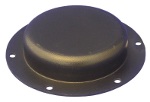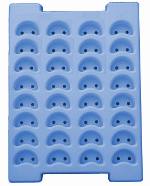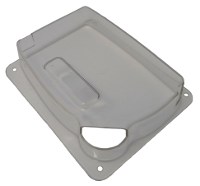Vacuum Forming - Finishing Methods
Once your vacuum formed items have been made, there are a number of ways of finishing them.
Packaging items may need euroslots to hang them on shop racking, vacuum formings may need cable holes or other features added to make them complete. Below is an overview of the various finishing options and their advantages and disadvantages.
Guillotining
Guillotining is a clean way of removing vacuum formed parts from the material sheet and as it doesn't require extra tooling, it's suitable for low volumes of parts where straight lines are no problem.
However, you can only guillotine cut straight lines and so can't make nicely rounded corners and as it's a fairly slow method, it's expensive for larger quantities.
Drilling
If you need some simple holes in your vacuum forming, manually drilling them is a good solution for small quantities. The part to the right was hand-drilled using a metal ring-shaped guide to ensure the holes are equidistant.
However, for larger volumes, having someone drill out individual holes is simply not cost-effective.
Roller Cutting
This is fast and efficient way of cutting vacuum formed items from the original sheet of vacuum
forming material. The cutter can also cut any holes for cables, euroslots or any other shape of holes at the same time. The roller cutting process is excellent for fairly large items, where precision alignment isn't required - the tray to the right was roller cut out of the plastic sheet, with the cutter used to punch the holes at the same time.
However, as the vacuum formings and the cutter are rolled sideways through the roller cutter machine, some misalignment can occur, making the method unsuitable for items that need very precise location of features. For very low volumes, it may not be cost-effective to have the roller cutter made. Roller cutting can't be used for making holes or features in the sides of vacuum formings, as the cutter tool always cuts vertically from the bottom - see roller cutting process.
Vertical Press cutting
This is a very precise method of cutting which uses a press and precison made cutting tools. The press cutting process is very suitable for items where the roller cutter process wouldn't achieve the precision required. It's often used for punching very small finished items out of a plastic sheet, rather than punching features into a product.
However, press cutting tools are more expensive than roller cutter tools and just like the roller cutter
method, press cutting can't be used to make features in the sides of vacuum formings.
CNC machining
Machining the parts is a very precise method of creating holes & features. The real advantage is that it can be used to create features in the sides of vacuum formings, e.g. guide rails for a tray that needs to slide onto shelving. It can also cut sidewalls of a different depth than the pockets - which can't be done with roller or press cutting.
However, it's a more expensive and slow for profile cutting compared to roller cutting.
We offer all these finishing methods and can advise you which one is right for your product. Find out more about our vacuum forming service, or

